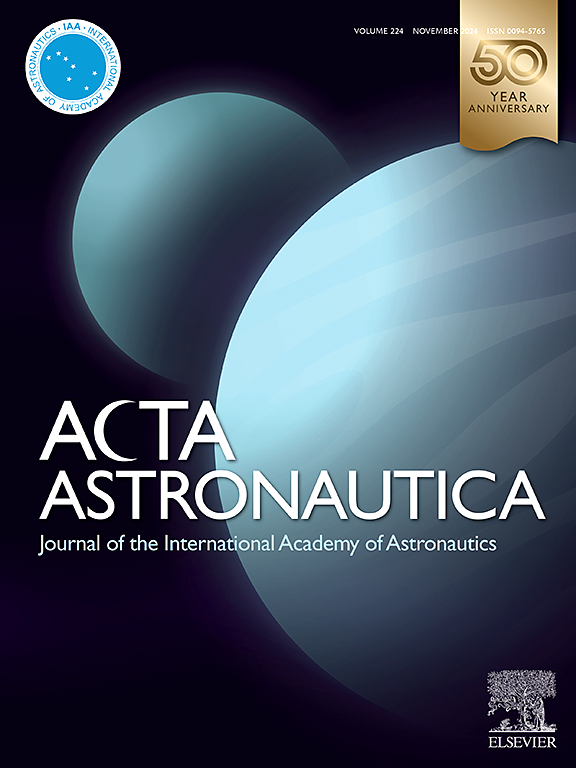Thrust performance of pulsed-laser ablation impulses for wavelengths of 1064 nm and 532 nm
IF 3.1
2区 物理与天体物理
Q1 ENGINEERING, AEROSPACE
引用次数: 0
Abstract
Space propulsion using pulsed-laser ablation of metals is a promising technology, particularly for deorbiting space debris or satellites at the end of life. The momentum coupling coefficient, a key parameter in this technology, depends on the incident laser wavelength. Although former studies have evaluated this dependency, they often overlooked the influence of variations in beam profiles. A method to estimate the local momentum coupling coefficient based on beam profiles was previously demonstrated using a nanosecond laser with a wavelength of 1064 nm. In this study, the local momentum coupling coefficient for a wavelength of 532 nm was estimated for the target materials of pure aluminum, extra-super duralumin, and oxygen-free copper using the same method and compared with that of the 1064 nm reported in the previous study. The comparison revealed that the local momentum coupling coefficient displays similar trends across materials for both wavelengths, except for oxygen-free copper, which exhibited a significantly higher ablation threshold for the wavelength of 1064 nm. The two important parameters for space propulsion, namely, the specific impulse and thrust efficiency, were also derived for both wavelengths based on the impulse and reduction mass of an ablation target. The specific impulse showed a weaker dependency on wavelength, with values ranging from approximately 2700 to 3100 s for pure aluminum, 2300–2600 s for extra-super duralumin, and 1500–2000 s for oxygen-free copper. These results are consistent with the tendency reported in a previous study that materials with a lower mean atomic weight yield higher specific impulse. In contrast, thrust efficiency clearly varied depending on material and wavelength, being approximately 40 %, 36 %, and 21 % at λ = 532 nm, and 32 %, 31 %, and 12 % at λ = 1064 nm for pure aluminum, extra-super duralumin, and oxygen-free copper, respectively. These findings provide valuable insights into the wavelength dependency of laser ablation thrust performance and its implications for space propulsion systems.
波长为1064 nm和532 nm的脉冲激光烧蚀脉冲的推力性能
利用脉冲激光烧蚀金属的空间推进技术是一项很有前途的技术,特别是对于在寿命结束时脱离轨道的空间碎片或卫星。动量耦合系数是该技术的关键参数,它取决于入射激光的波长。虽然以前的研究已经评估了这种依赖性,但他们往往忽略了光束轮廓变化的影响。利用波长为1064 nm的纳秒激光,提出了一种基于光束轮廓估计局部动量耦合系数的方法。在本研究中,我们用同样的方法估算了纯铝、超超硬铝和无氧铜等目标材料在532 nm波长下的局部动量耦合系数,并与前人报道的1064 nm波长下的局部动量耦合系数进行了比较。结果表明,除了无氧铜在1064 nm波长表现出更高的烧蚀阈值外,两种材料的局部动量耦合系数呈现出相似的趋势。根据烧蚀目标的冲量和减重质量,导出了两种波长的空间推进的两个重要参数,即比冲量和推力效率。比脉冲对波长的依赖性较弱,纯铝的比脉冲约为2700 ~ 3100 s,超硬铝的比脉冲约为2300 ~ 2600 s,无氧铜的比脉冲约为1500 ~ 2000 s。这些结果与先前研究报告的趋势一致,即平均原子量较低的材料产生较高的比脉冲。相比之下,推力效率明显取决于材料和波长,在λ = 532 nm处分别约为40%、36%和21%,在λ = 1064 nm处,纯铝、超硬铝和无氧铜的推力效率分别为32%、31%和12%。这些发现为激光烧蚀推力性能的波长依赖性及其对空间推进系统的影响提供了有价值的见解。
本文章由计算机程序翻译,如有差异,请以英文原文为准。
求助全文
约1分钟内获得全文
求助全文
来源期刊

Acta Astronautica
工程技术-工程:宇航
CiteScore
7.20
自引率
22.90%
发文量
599
审稿时长
53 days
期刊介绍:
Acta Astronautica is sponsored by the International Academy of Astronautics. Content is based on original contributions in all fields of basic, engineering, life and social space sciences and of space technology related to:
The peaceful scientific exploration of space,
Its exploitation for human welfare and progress,
Conception, design, development and operation of space-borne and Earth-based systems,
In addition to regular issues, the journal publishes selected proceedings of the annual International Astronautical Congress (IAC), transactions of the IAA and special issues on topics of current interest, such as microgravity, space station technology, geostationary orbits, and space economics. Other subject areas include satellite technology, space transportation and communications, space energy, power and propulsion, astrodynamics, extraterrestrial intelligence and Earth observations.
 求助内容:
求助内容: 应助结果提醒方式:
应助结果提醒方式:


